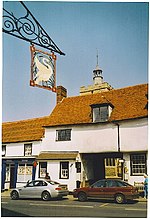North End, Essex
City of ChelmsfordEssex geography stubsGreat WalthamHamlets in Essex

North End is a hamlet at the northern end of the parish of Great Waltham in the Chelmsford district of Essex, England. Black Chapel Cottage, a former priest's house, is a Grade II* listed building. It was repaired in about 1950 after wartime bomb damage.The Prodigy singer Keith Flint was a resident of North End from 1997 until his death in 2019.
Excerpt from the Wikipedia article North End, Essex (License: CC BY-SA 3.0, Authors, Images).North End, Essex
Brook Hill, Chelmsford Great Waltham
Geographical coordinates (GPS) Address Nearby Places Show on map
Geographical coordinates (GPS)
| Latitude | Longitude |
|---|---|
| N 51.84 ° | E 0.415 ° |
Address
Brook Hill
Brook Hill
CM6 3PF Chelmsford, Great Waltham
England, United Kingdom
Open on Google Maps








